In this article I am going to answer questions like:
- What keywords should you target from your list and which one to delete?
- How should you target your keywords to rank in search?
- What content should you be creating to target a keyword?
- What information your users are looking for?
- What keywords will bring the best opportunities for your business?
And many more questions I will answer by showing you everything you need to know about keyword analysis and how to do it after you have completed your keyword research.
Let’s get started:
What is Keyword Analysis?
A keyword analysis is an essential process of analyzing your targeted keyword that you found during keyword research to gain important insights about the keyword that you want to target in order to vet irrelevant keywords for your business, know what information users are searching for, what content you should create to target the keyword as well as what LSI keywords you should include in your content.

A keyword analysis is an essential part of your keyword targeting that you should do before you start producing any content on your website.
Why Do You Need to Do Keyword Analysis in SEO?
Keyword analysis works as a vetting process for keywords you have found during keyword research to eliminate any irrelevant keywords, keywords you cannot target for reasons I will show you, or keywords that have no value to your business.
As I said, keyword analysis is an essential step during keyword targeting as it gives you essential information about the targeted keyword such as:
- Whether the keyword is primary or secondary
- What is the search intent of a keyword
- Whether you can target the keyword on your website
- What content you should create to target the keyword
- What LSI keywords you should include improving keyword targeting
Therefore, before you start producing any content on your website, you need to understand the keyword by doing keyword analysis in order to rank in SERPs.
Because if you don’t do that then you might be targeting the wrong keyword, creating the wrong piece of content, not giving users the information they are looking for, or end up with keyword cannibalization.
And in any case, it means your web page will not rank in SERPs and you would waste your marketing resource.
Therefore, it is essential to do keyword analysis before you start targeting the keyword to decide if you can target and rank for the keyword or you should avoid it to focus only on those keywords that truly matter to your business.
Keyword Analysis vs Keyword Research: What’s the Difference?
And before we start going deeper on how you can do keyword analysis for SEO, let me first run you through the differences between keyword analysis and keyword research.
The first and biggest difference is that keyword research is a process to find keywords and keyword analysis is a process to analyze the keywords you have found during keyword research. Usually, experienced marketers will run those simultaneously.
The second difference, keyword analysis gives you important information on how you should target a particular keyword, while keyword research gives you a list of keywords related to your niche and topics and helps you to formulate topic clusters.
Another difference, keyword analysis gives you data about your keywords such as keyword difficulty, search volume, CPC, etc, while keyword research gives you primary and secondary keyword ideas people are searching for in your niche.
And lastly, keyword analysis helps you to make informed decisions about your actions for the best SEO results, and keyword research helps you to create laser focus for your targeting.
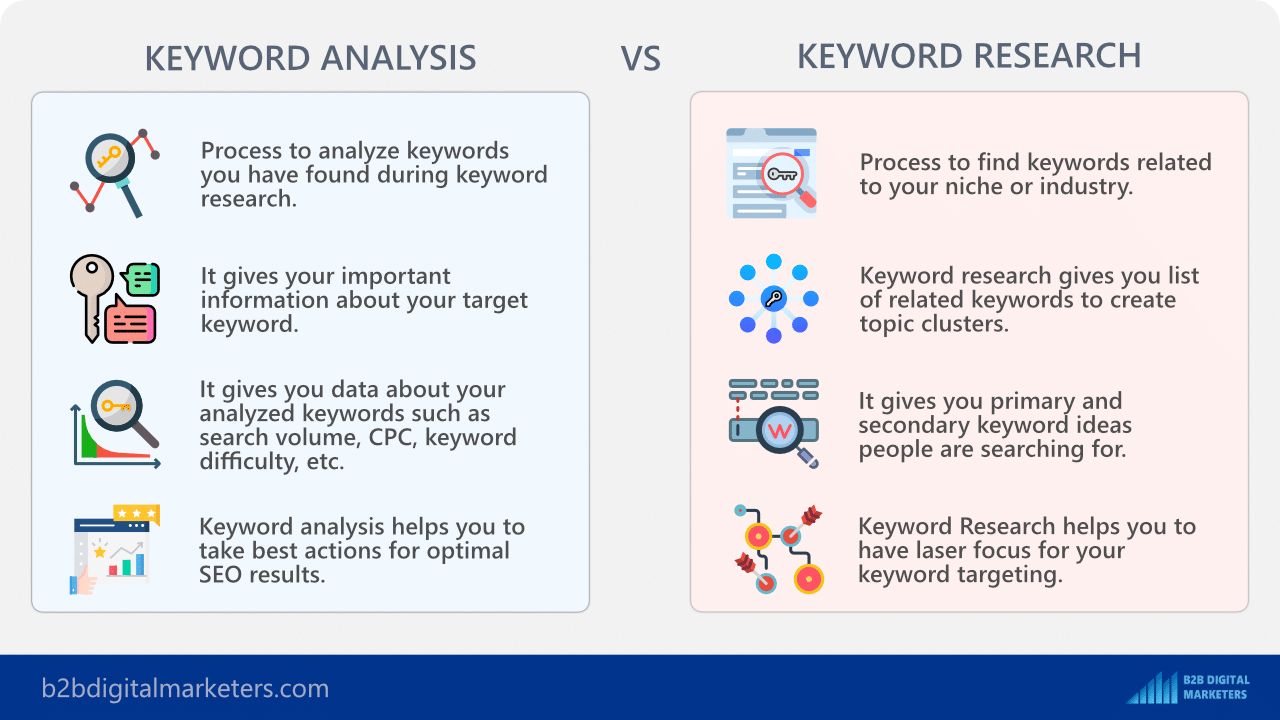
How To Do Keyword Analysis in SEO?
A keyword analysis is very simple, but an essential step that you must perform for every of your keyword. Because it gives you the answer to whether you can target the keyword with your website or not.
Therefore, as we progress you will learn how to quickly remove keywords that have no sense for you to target, thus not wasting your time and marketing resource.
So, here are the 5 Steps of Keyword Analysis for Website:
Step #1: Identify If Keyword is Primary or Secondary
The first step of keyword analysis is to determine if your keyword is primary or secondary.
The primary keyword is the main keyword that you will be targeting with a dedicated piece of content while a secondary keyword is a keyword that does not have actual targeting, thus, another primary keyword/s rank for the secondary keyword.
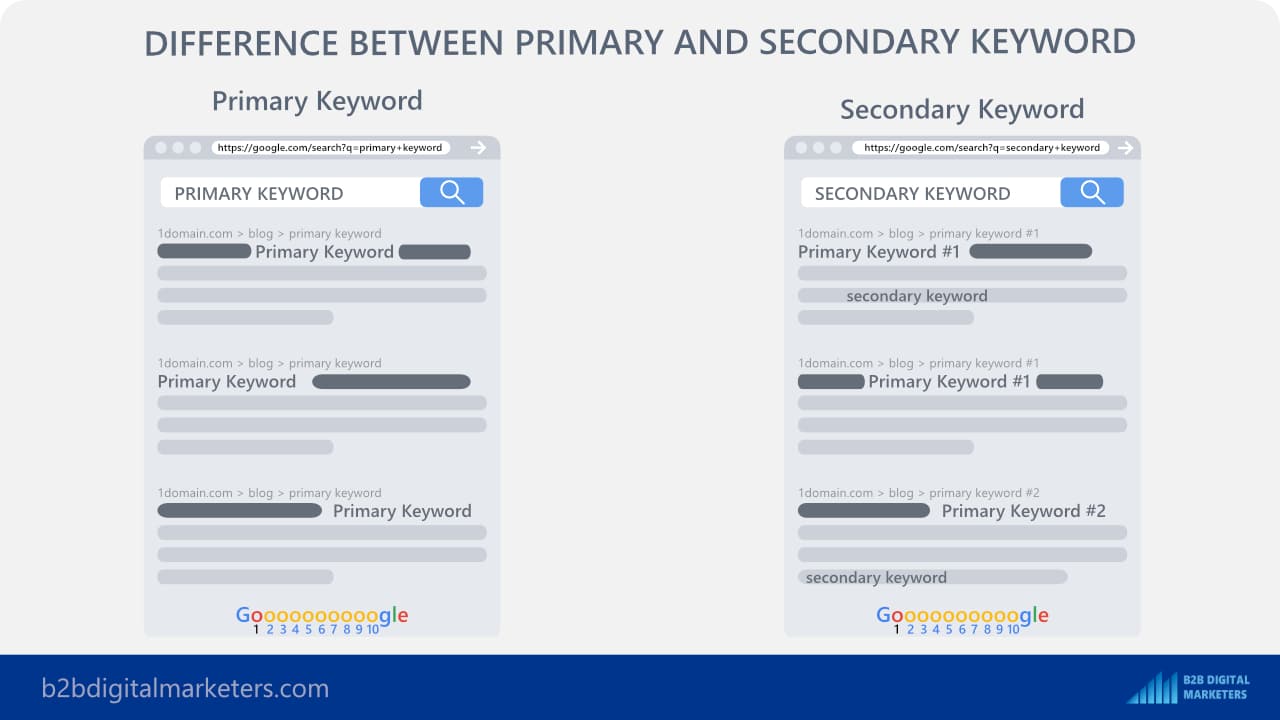
Therefore, targeting a secondary keyword with a dedicated piece of content would be a waste of your time, and instead, you should find the primary keyword that is ranking for the secondary keyword, target that and add the secondary keyword in the content as an LSI keyword.
So, for you to better understand it, let me give you a few examples of how you can analyze if a keyword is primary or secondary.
Example #1: Keyword: “seo strategies”
So, to analyze whether the keyword “seo strategies” is primary or secondary just pop it into Google or keyword research tool.
I honestly prefer the keyword research tool, as it removes any personalization and I can get the exact organic results for my targeted location, however, either way will work fine.
So, let’s take the keyword and enter it into SE Ranking keyword research tool, select the targeted location, and click on “Analyze”.

Here, I will get important information about the analyzed keyword such as the keyword difficulty, search volume, cost per click, and keyword ideas. All this information is important during the keyword research process or we will use it during the keyword analysis.

So now, I will go to the “Organic Results” report to see what pages are ranking for the analyzed keyword.
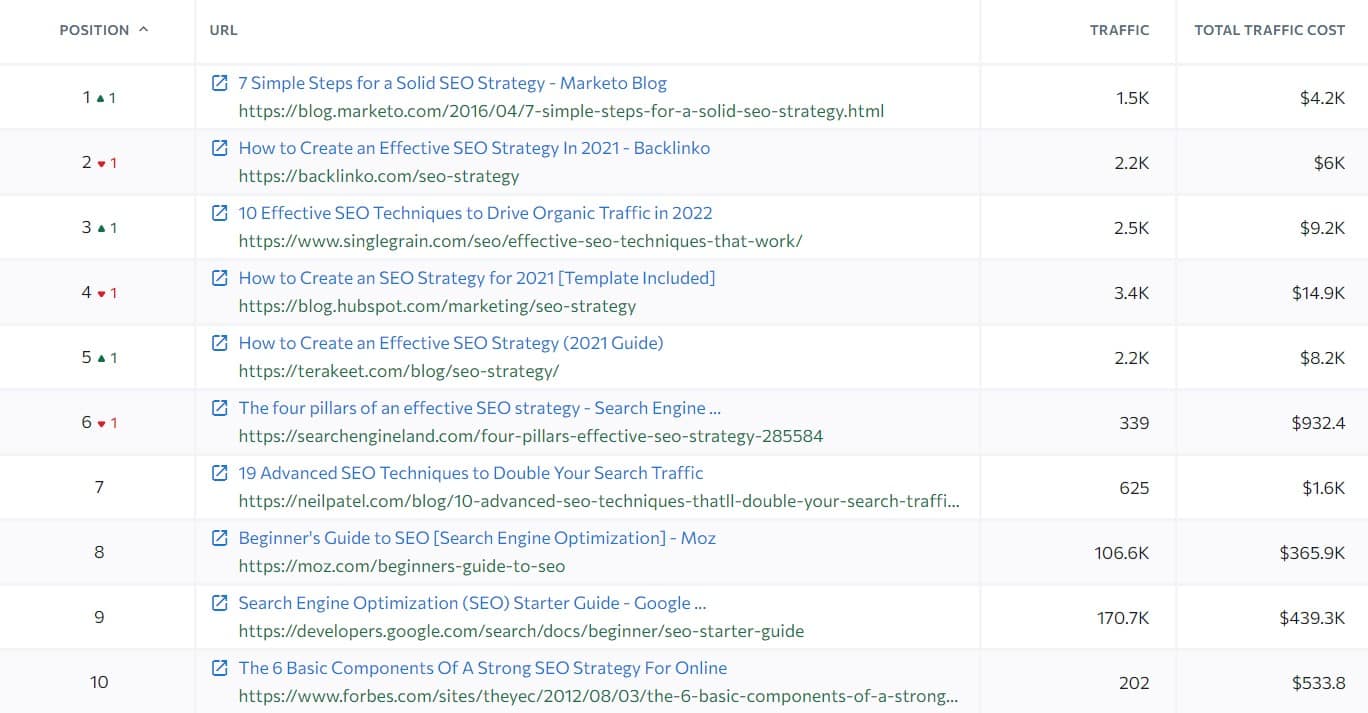
Now, based on the organic search results I can clearly see, that the keyword “seo strategies” is a secondary keyword as it ranks for different primary keywords, which in this case, it ranks for two primary keywords.
The first primary keyword is “seo strategy” as you can see according to the top-ranking pages.
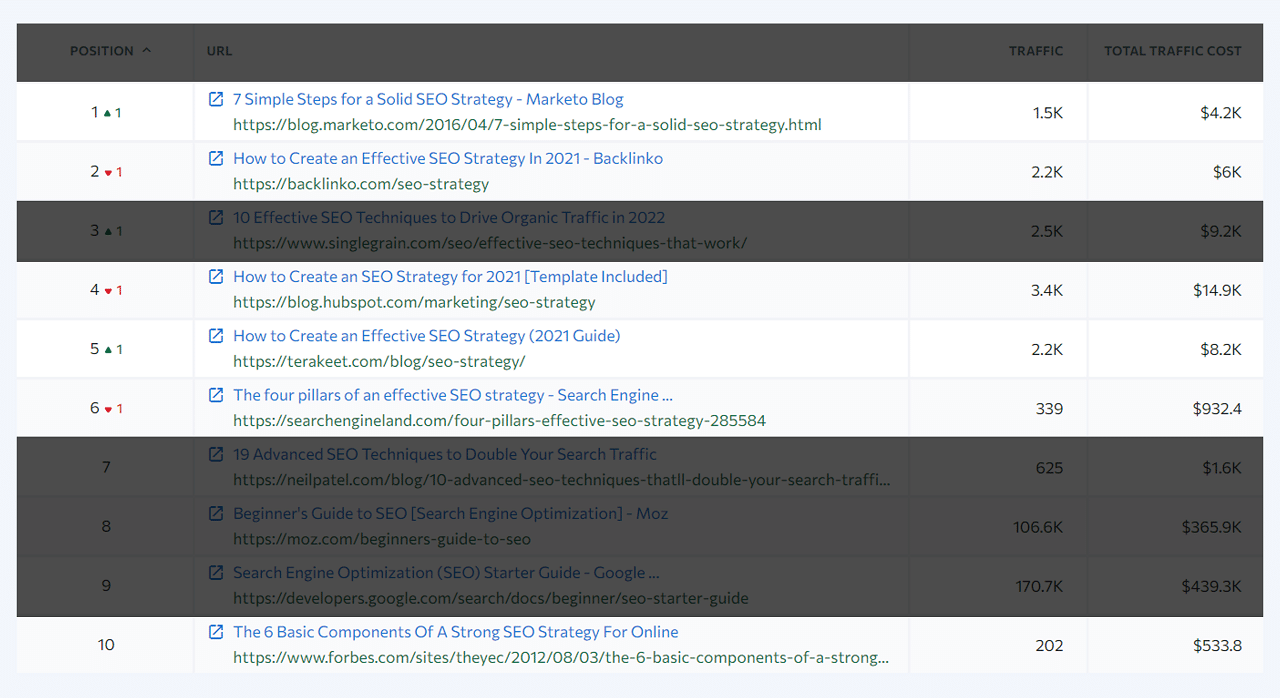
And the second primary keyword is “seo techniques”, again according to the organic ranking pages.
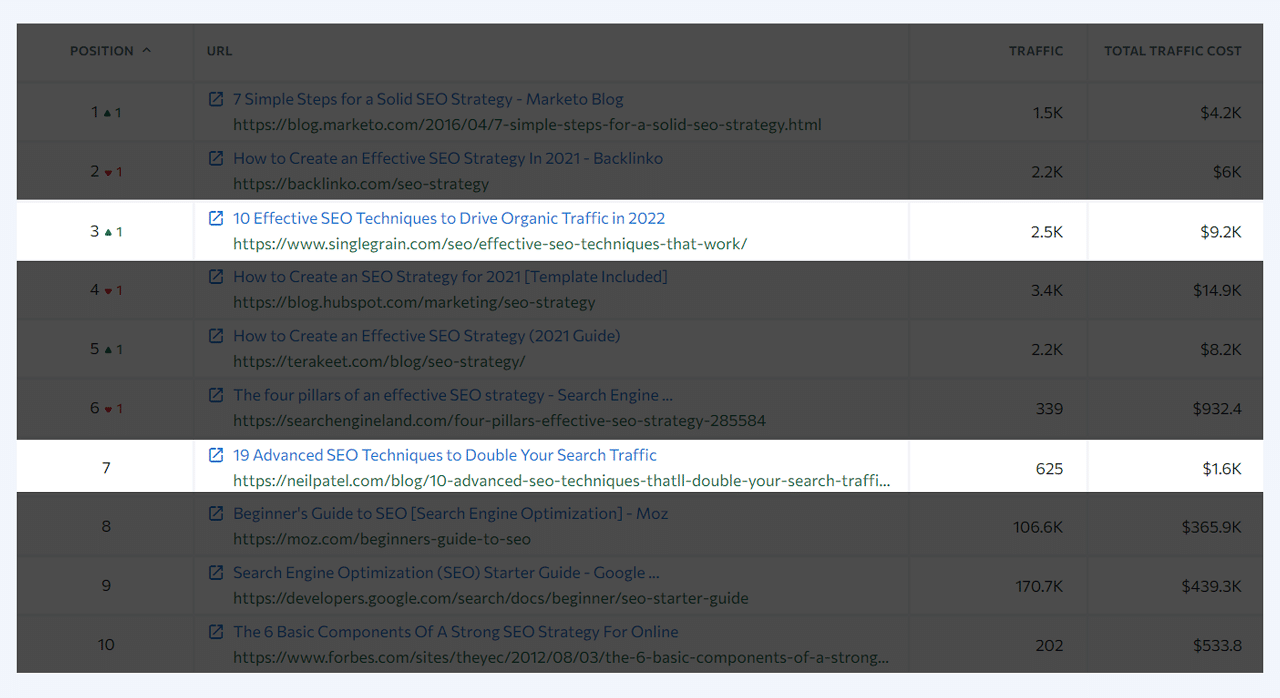
This means, if I want to rank for this keyword, I must target the two primary keywords “seo strategy” and “seo techniques” and add the keyword “seo strategies” as the LSI keyword for these two primary keywords.
Example #2: Keyword “types of mouse”
Again, I will put the keyword into the SE Ranking Organic Results report to see what pages are ranking in the Organic SERP to determine if the keyword is primary or secondary.
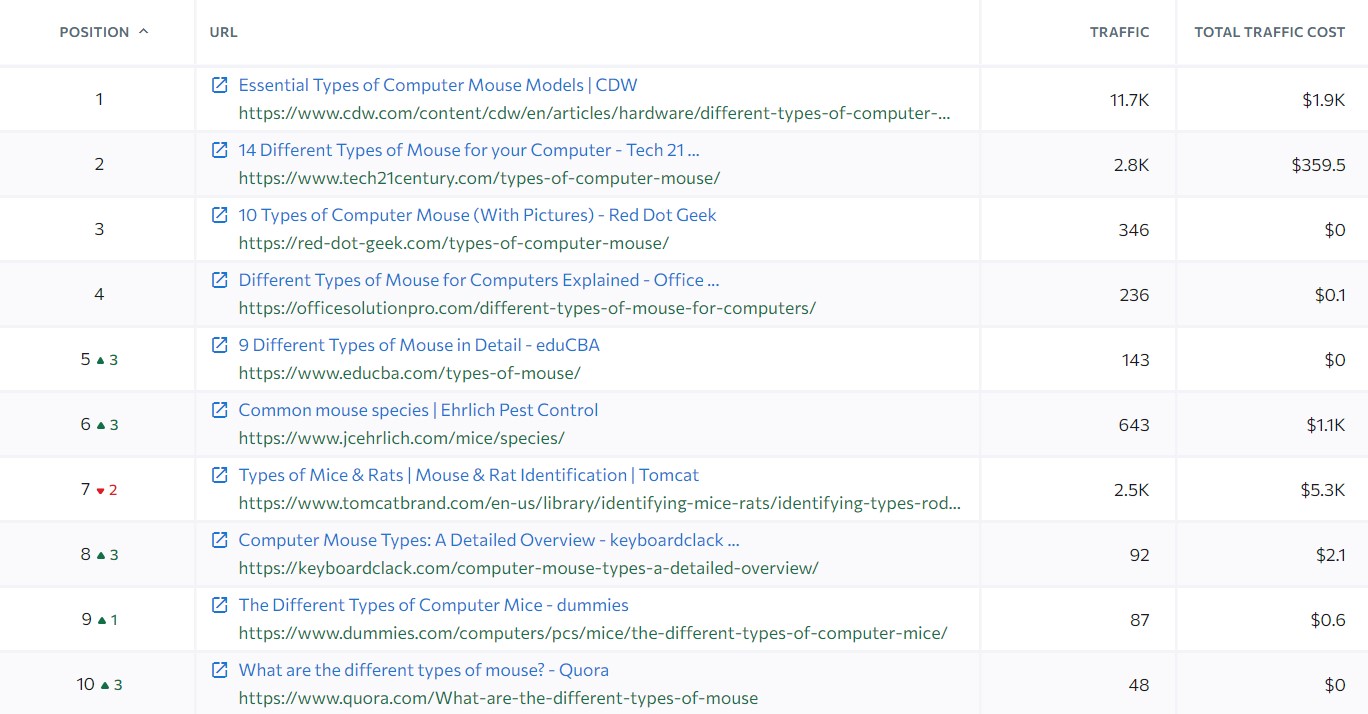
Obviously, this keyword is a primary keyword.
However, as you could probably realize, this keyword has two different meanings, and as you can see, people are more interested in a computer rather than an animal mouse for this keyword.
Therefore, this keyword is perfect for those that want to target this keyword and write about a computer mouse.

But if you are owning a pet store, or writing about different types of animal mice, then instead of targeting the keyword “types of mouse”, you would be targeting the keyword “types of mice”.
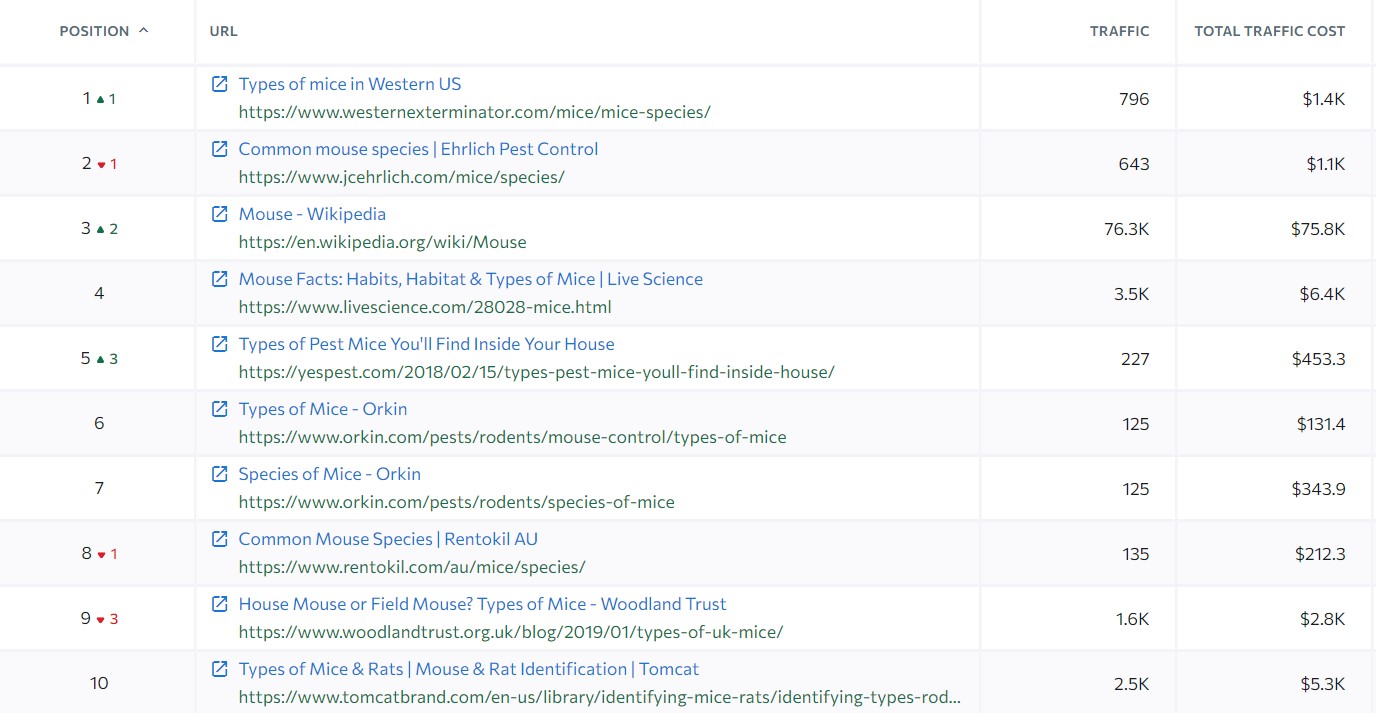
This is another reason why it is so important to do keyword analysis before you start targeting keywords as you might end up very disappointed.
Step #2: Analyze Search Intent
Once you have determined if the keyword is primary or secondary, the second step is to analyze search intent.
Search intent means the reason behind the search query and it represents what users want to see when they type the query.
Therefore it is another crucial part of keyword analysis because if you don’t meet the search intent, your page won’t rank for the targeted keyword.
And to determine search intent is a relatively simple task, but first, you need to know the four different types of search intent:
- Informational: Here you will see predominantly blog posts, Wikipedia pages, forums, and other types of content that are purely focused on content and the information value. Typically these are the what, how, when, and why types of pages.
- Commercial: As the name suggests here you will see more commercial types of pages. Typically, this is category pages, reviews, a list of best tools, or comparison types of pages.
- Transactional: Here you will see predominantly product, service, and category pages as the user decided on the product or service they want to purchase.
- Navigational: These are keywords that you typically use to navigate somewhere you already know or get results from certain domains. Such keywords contain the brand name you want to visit.
Knowing how to analyze search intent is important so you can deliver the right type of content to your users and map keywords for the buyer journey to ensure you target keywords across all stages of the buyer journey. (Learn more about keyword mapping.)
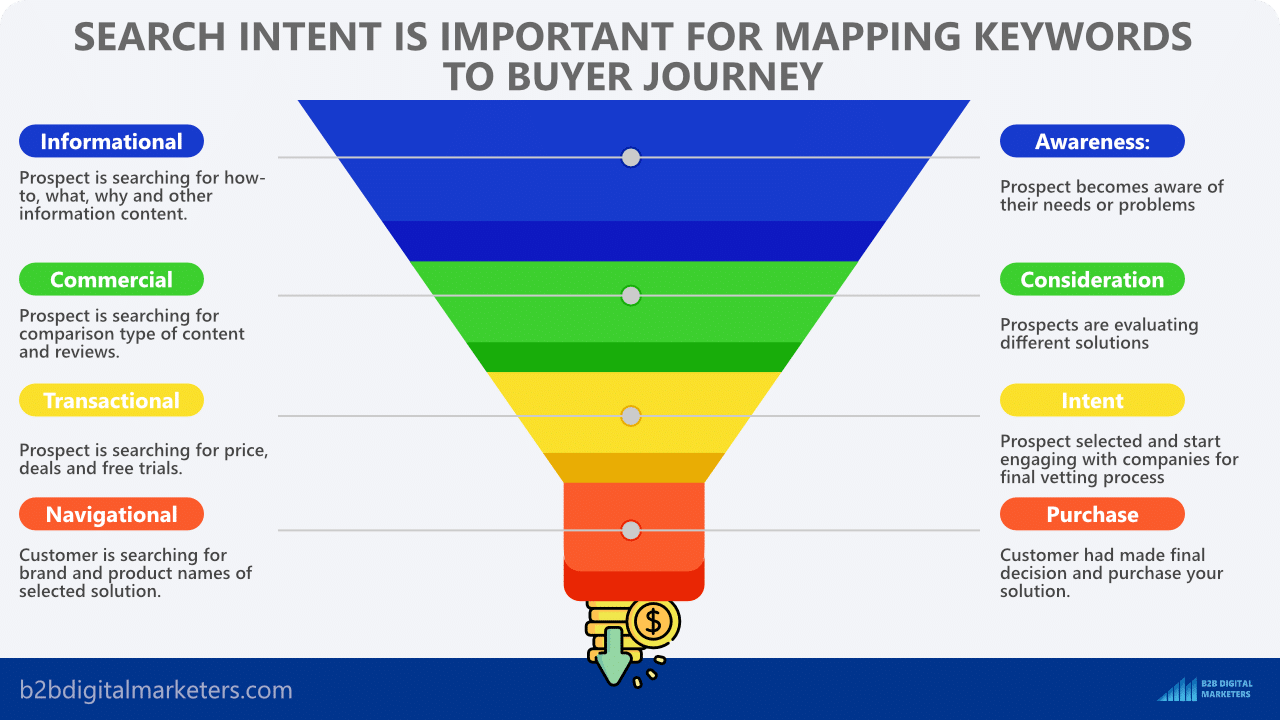
And, to analyze search intent we will look at the Organic search and also use the table of keyword modifiers that indicate certain types of search intent, but please take it with pinch of salt.
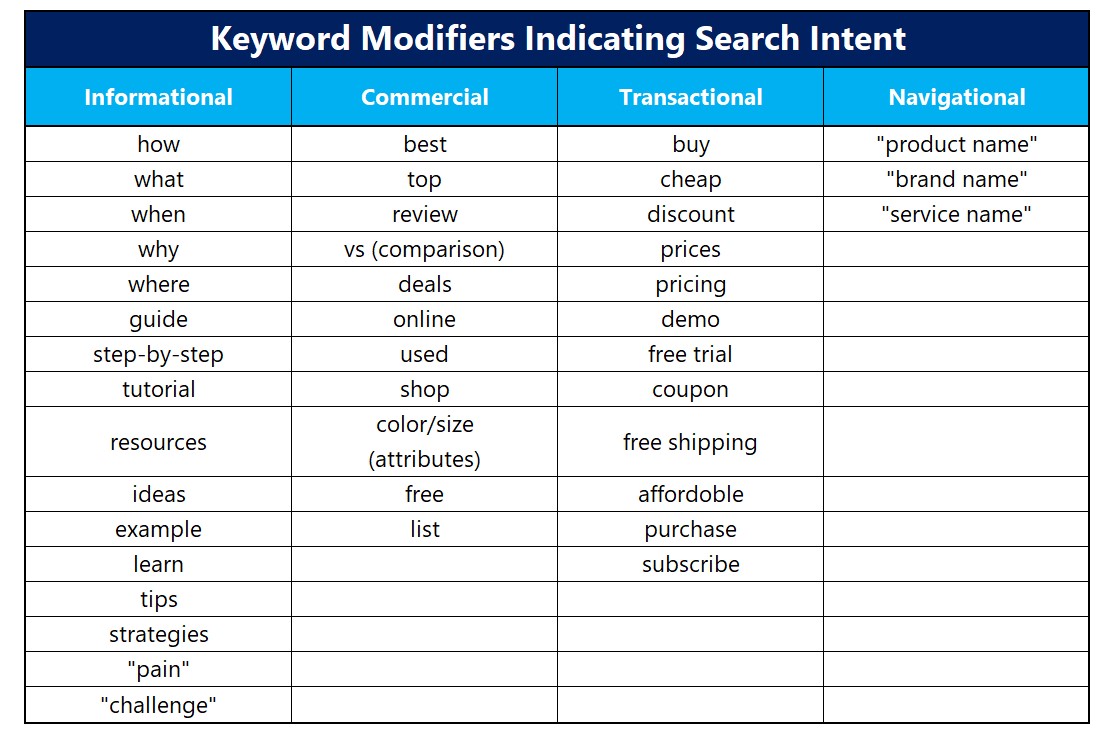
So, let’s have a look at a few examples:
Keyword Example #1: “business accounting”
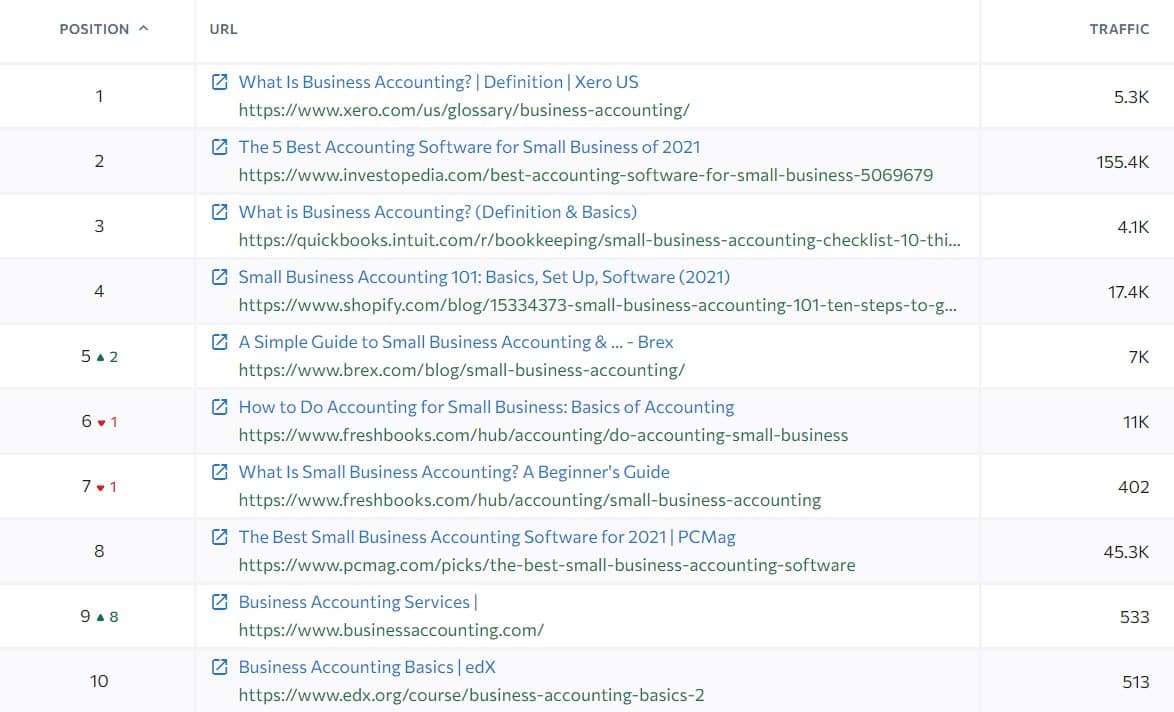
When you look at the organic results for this query, you can see that this keyword is predominantly informational type as you can see there are the keyword modifiers “what” and “guide”.
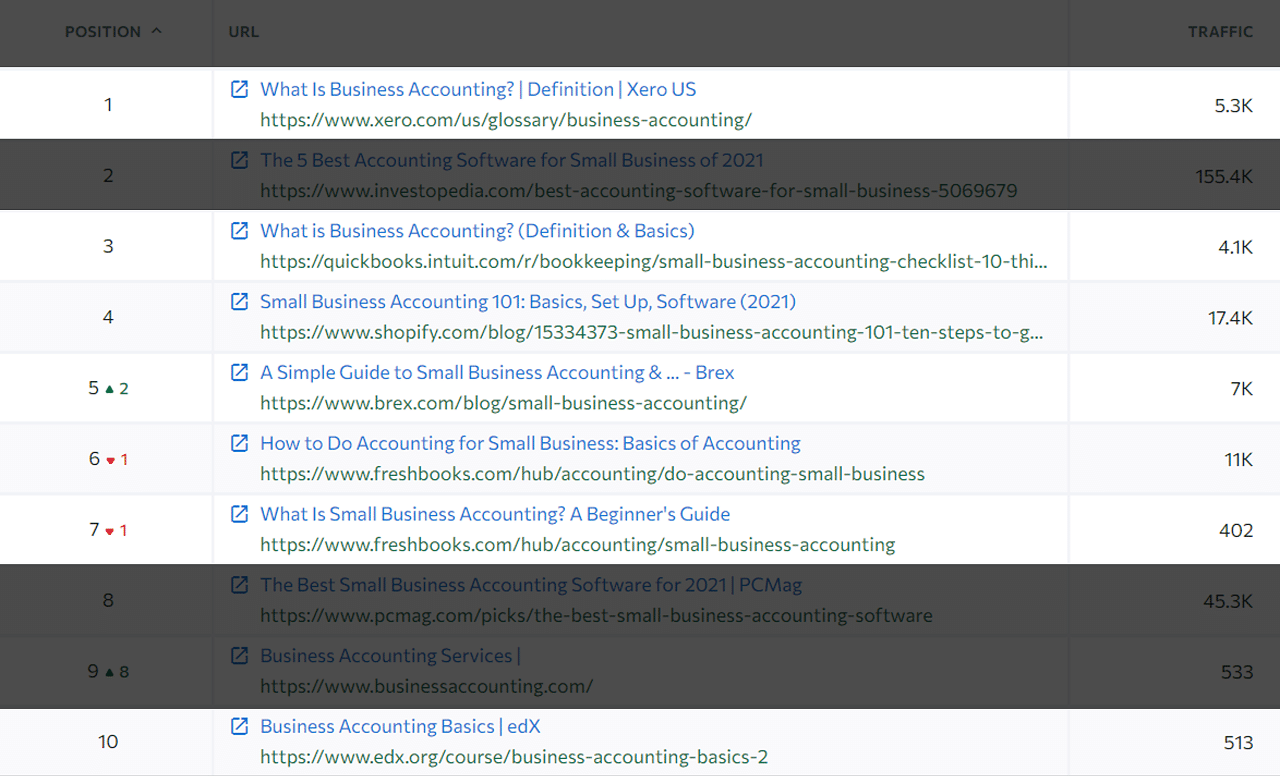
However, it has a bit of mixed search intent as there are pages with commercial search intent with the keyword modifier “best” and both of these pages are a list of recommended products.
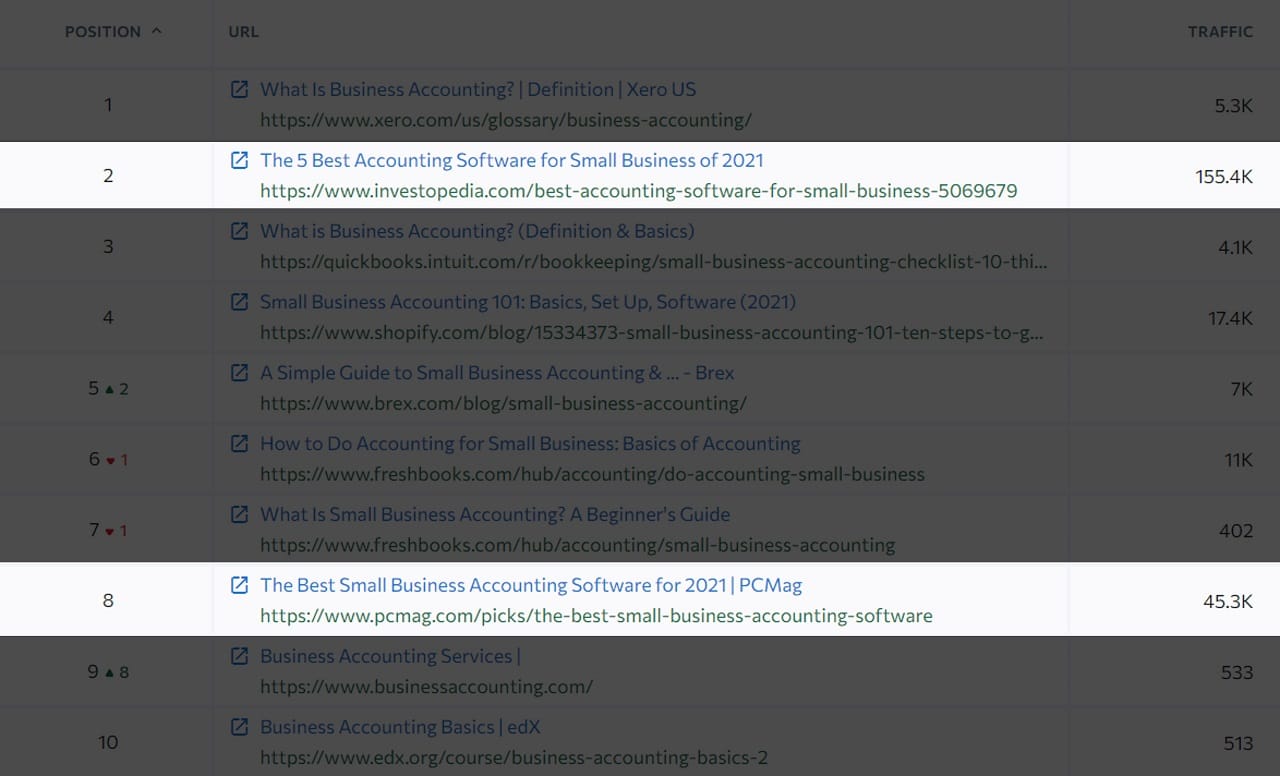
Keyword Example #2: “online accounting degree”
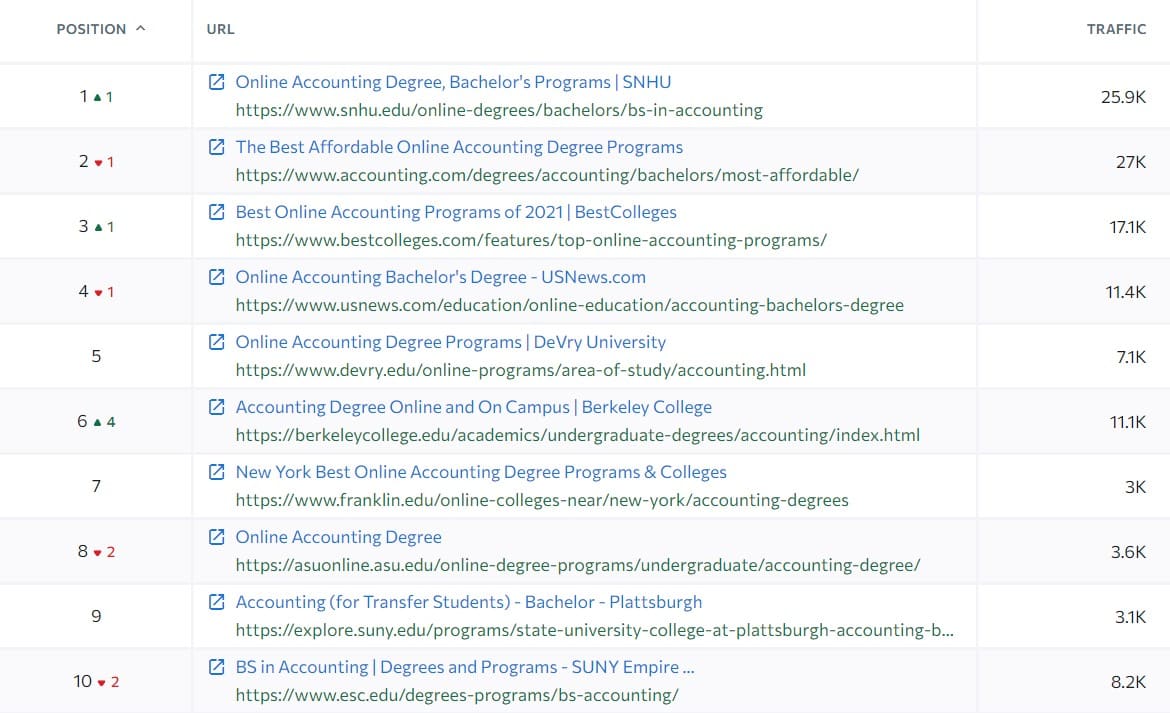
So, when you look at this keyword, again you can see a mix of search intent, in this case, you can see commercial type.

And also, you can see the transactional type with university product/service pages for their online accounting degree.

Keyword Example #3: “accounting software”
And when you look at the organic search for this query, it is clear as day, that this keyword is commercial type, because as you can see it is only the list of recommended accounting softwares with keyword modifiers “best” and “top”.
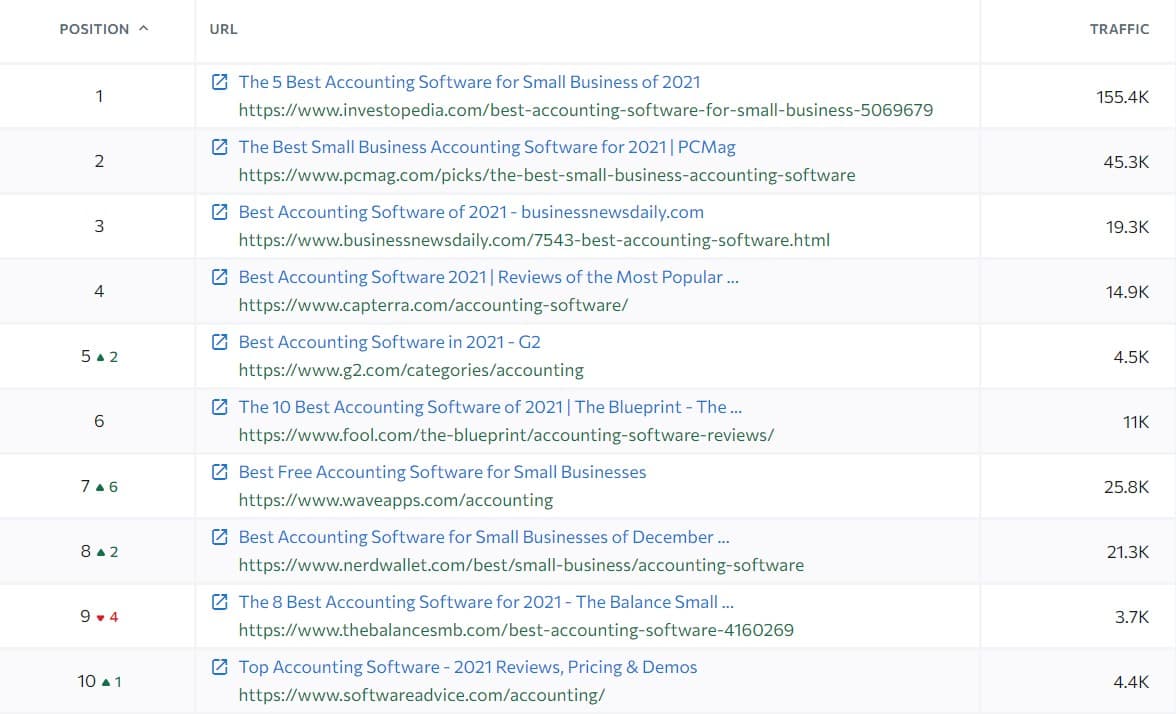
So, as you can see, analyzing search intent is not difficult at all, once you get a grasp on it.
Step #3: Target Search Intent with Right Content
The next step is to create the right type of content to meet the search intent.
Creating the right type of content to meet the search intent is crucial to your content creation process for SEO, as there is not really a point in target keywords when you can’t match the search intent.
However search intent can change and what was once a keyword not targetable for you, can change pretty quickly and you would be able to target it.
So, again, let’s give a few examples of how to target search intent with the right content.
Keyword Example #1: “diy raised garden beds”
So, let’s again have a look at the Organic results for this keyword.

Now as you can see, this is an informational type of keyword. Also, most of the ranking pages are on “how to build raised garden bed”, but you can see, that the first ranking page is different.
So what content should you create to target this keyword search intent?
Usually, when something like this happens it means the keyword has a broad meaning and Google is not sure which content you are looking for, thus giving you a different set of pages.
Therefore, to target this keyword I would recommend to create 3 different types of content to target this keyword:
- First, target the keyword “how to build raised garden bed”.
- Second, target the keyword “dyi raised garden bed ideas”.
- Third, target the keyword “dyi raised garden bed”, where you give a quick overview for both of the keywords/topics from above and link to each other, so it would work as a hub page for you.
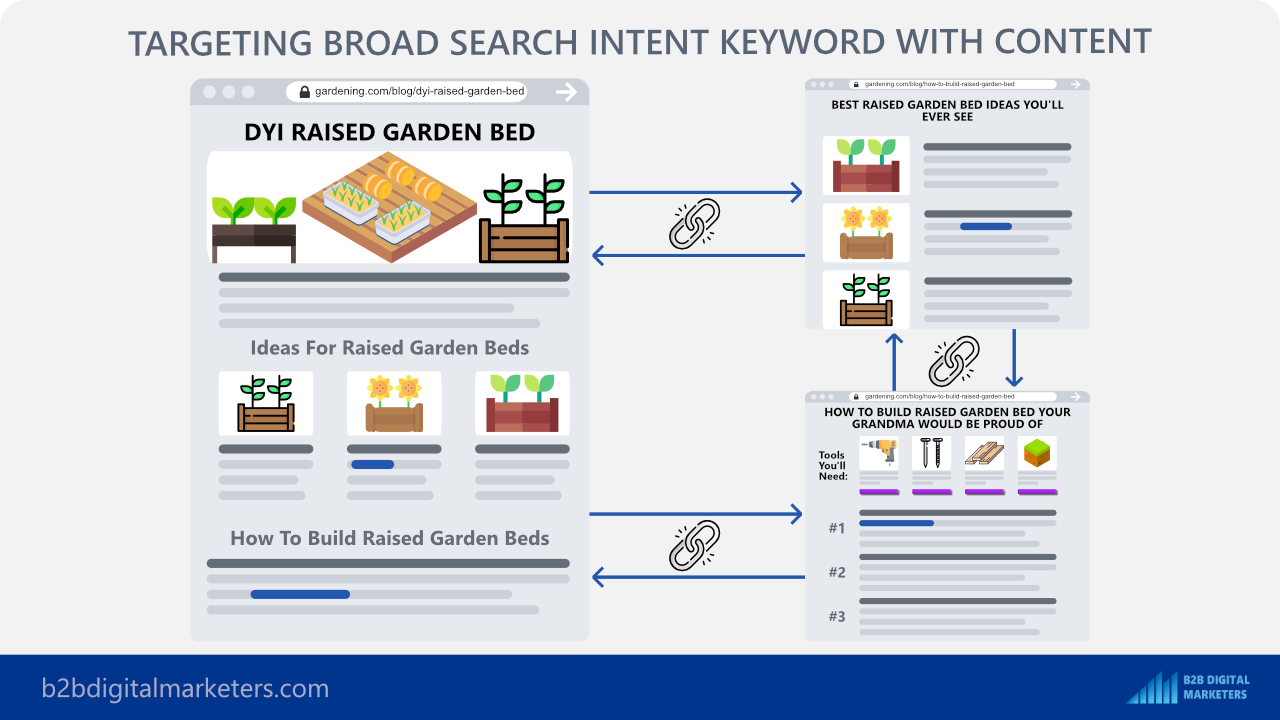
Like this, you start building topical relevancy and satisfy your users’ needs, which is exactly what Google is looking for.
Keyword Example #2: “gardening tool”
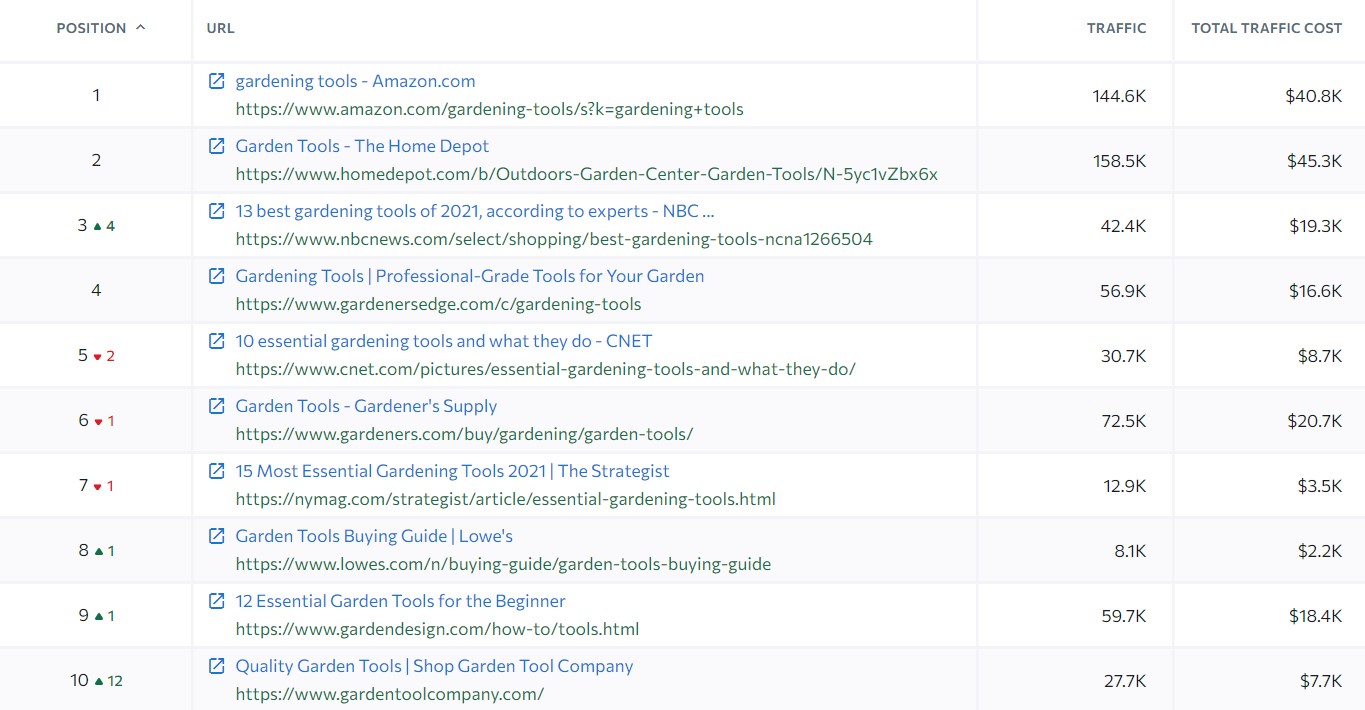
When you look at the Organic Results for this keyword, you can see, that this keyword has a mix of commercial and transactional search intent. Also, you can see two different types of results.
The first types of result are category pages of e-commerce shops.

And the second is a blog post with a list of the best gardening tools.
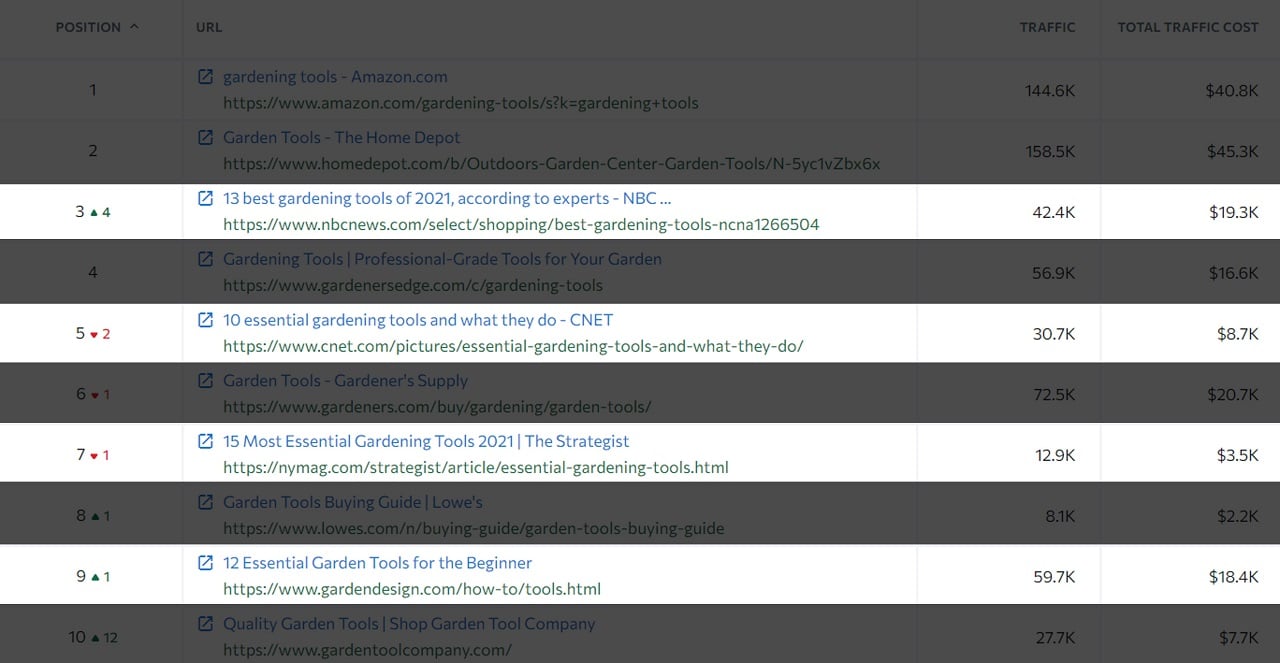
Now, depending on whether you are an e-commerce store, then you can create two types of pages to target the search intent. First is product category pages of your gardening tools and second is a blog post with a list of best gardening tools.
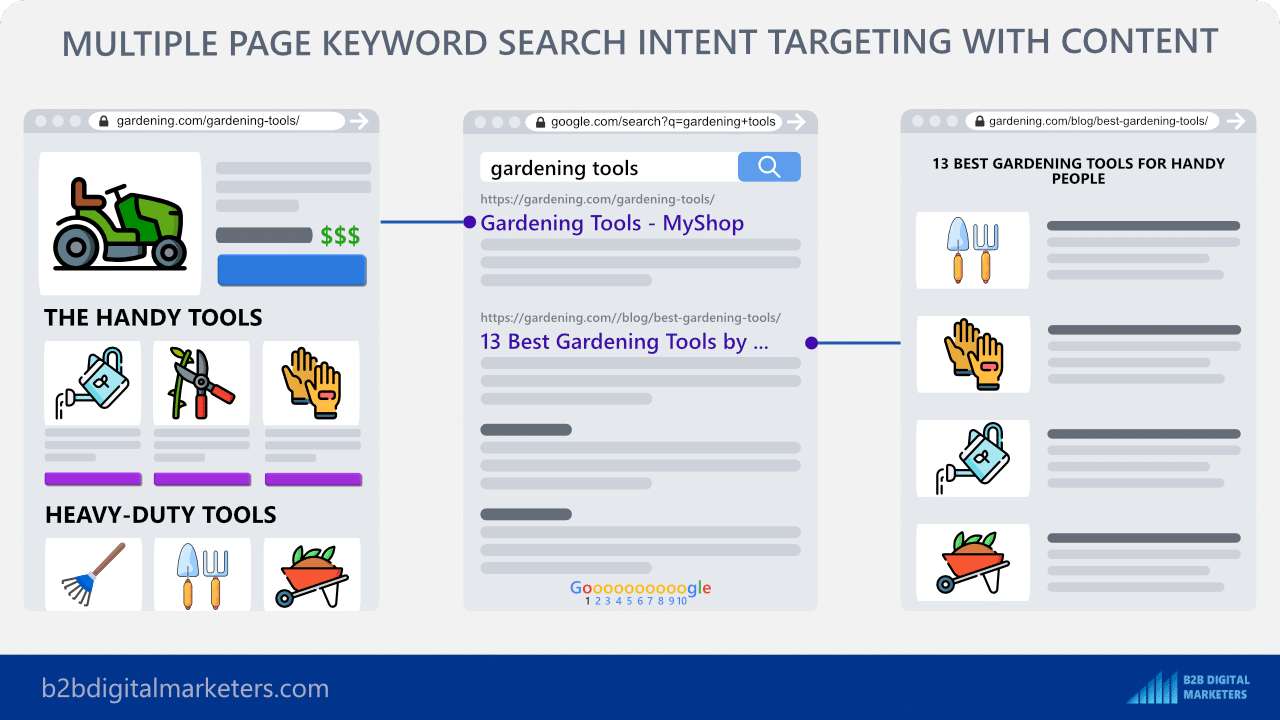
However, if you are running an affiliate site, then you can only create a blog post with a list of the best gardening tools. BTW if you are in gardering or landscape niche check out SEO for landscaping.
Also in some cases, you find that you cannot match the keyword search intent, thus, you should not waste your time by targeting the keyword with not the right content.
So, this is how you can target keyword search intent with your content. As you can see, often the search intent can be mixed and you will have several options to create your content.
Also, don’t worry if you are not sure and afraid of creating the wrong type of content. Often, the best way is to create content and see how it performs and then do adjustments.
Step #4: Analyze Keyword Business Potential for You
The fourth step of the keyword analysis process is to come up with the keyword business potential for your business.
Analyzing keyword business potential helps you to prioritize keywords that you should target first. It helps you to determine which keywords can bring you more business opportunities, thus, helps you to grow your business.
However, every marketer or business owner must figure out for themselves if the traffic the keyword brings to their website can generate revenue or increase brand exposure.
So, to find the keyword business potential you must always ask yourself:
- Is this keyword relevant to my business?
- Would be the users interested in my solution?
- Can I naturally include my solution within the post?
- And are they ready to buy? AKA where are they in the buyer journey?
And if the answer to the first two questions is no, then you obviously don’t want to waste your time on these. The third question is about the lead generation ability of the keyword and the last question is about where the user is in the buyer journey.
Also, by asking these questions I can easily assign a score between 0-3, 0 means no business potential and 3 great revenue-generating potential. Here is a guideline I am using to analyze keyword business potential with an example for Whiskey E-Commerce Store:

Remember, analyzing a keyword’s business potential helps you to find keywords that easily allow you to include your product or services as the hero of the story without sounding salesy or pushy.
Therefore, whenever you have a list of keywords with data like keyword difficulty, search volume, CPC, content type, search intent, and other information, don’t forget to also include a column for the “business potential” score.

Step #5: Find Relevant or LSI Keywords to Your Primary Keyword
And the very last step of the keyword analysis process is to find relevant or LSI keywords to your primary keyword.
After you have completed the four previous steps you should a nice list of vetted high-quality keywords for your business that is ready to be targeted.
So, whenever you pick a primary keyword you want to target you need to find any relevant keywords that frequently co-occur together with your primary keyword.
So let me show you example a few techniques on how to find LSI keywords for the keyword “best whiskey cocktails”
Technique #1: Use Your Brain
Before you start looking for LSI keywords, first you should use your own experiences as that’s what makes you stand out, unique, and often gives you the competitive advantage and better chance to rank in top positions.
So, open your document and start writing your outline just by using your brain and what topics or ideas you would want to discuss when you are targeting the keyword.
In my example, it could be something like this:
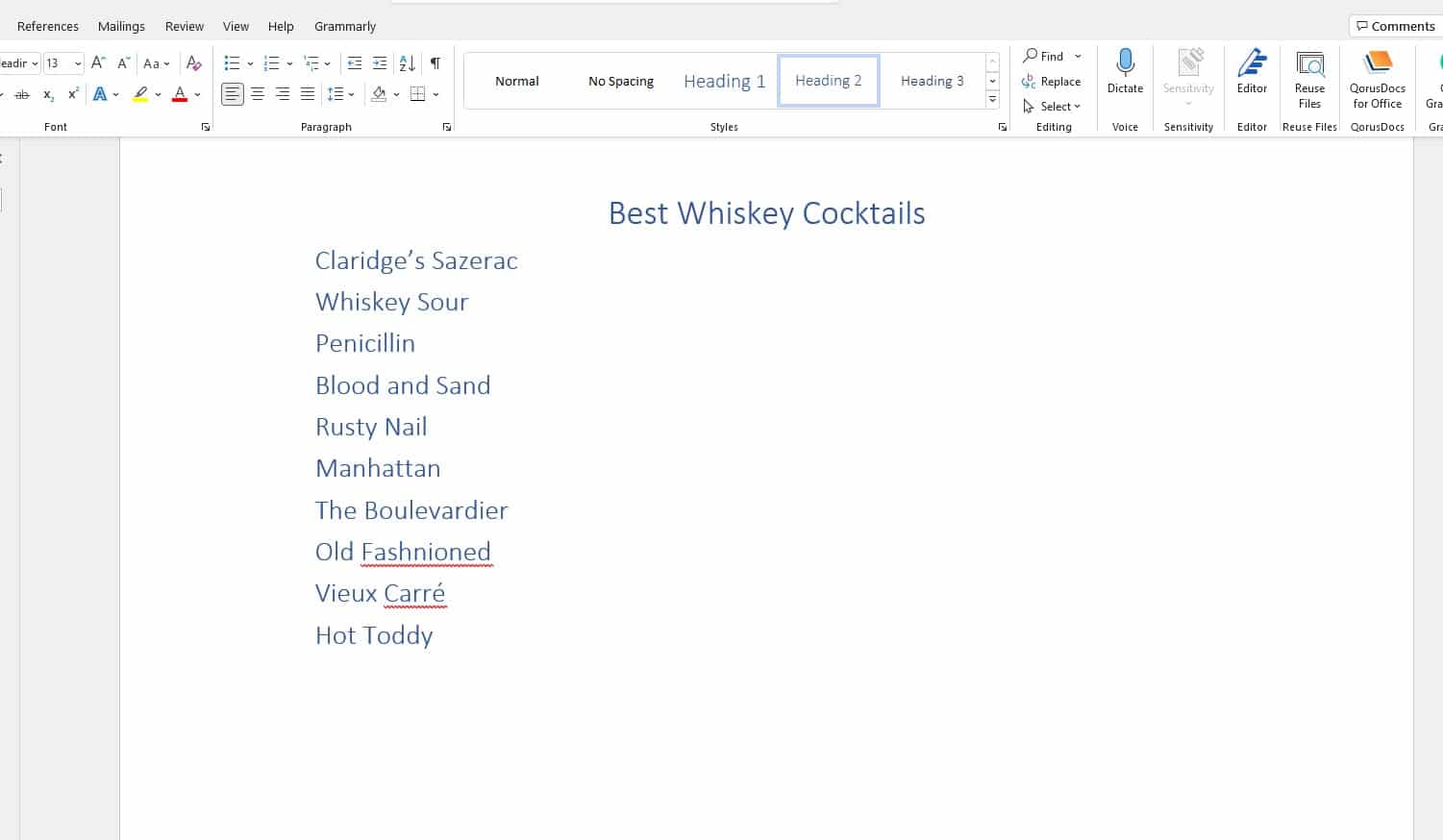
Please bear in mind that this is only for demonstration purposes and if I would be a professional bartender-the list would be different.
Technique #2: Analyze Top Ranking Competitors Topics
The second technique you will want to do is to analyze top-ranking competitors for your ranking keyword.
So, for me, I would look at the top-ranking competitors for my target keyword “best whiskey cocktails” and see what cocktails others included.
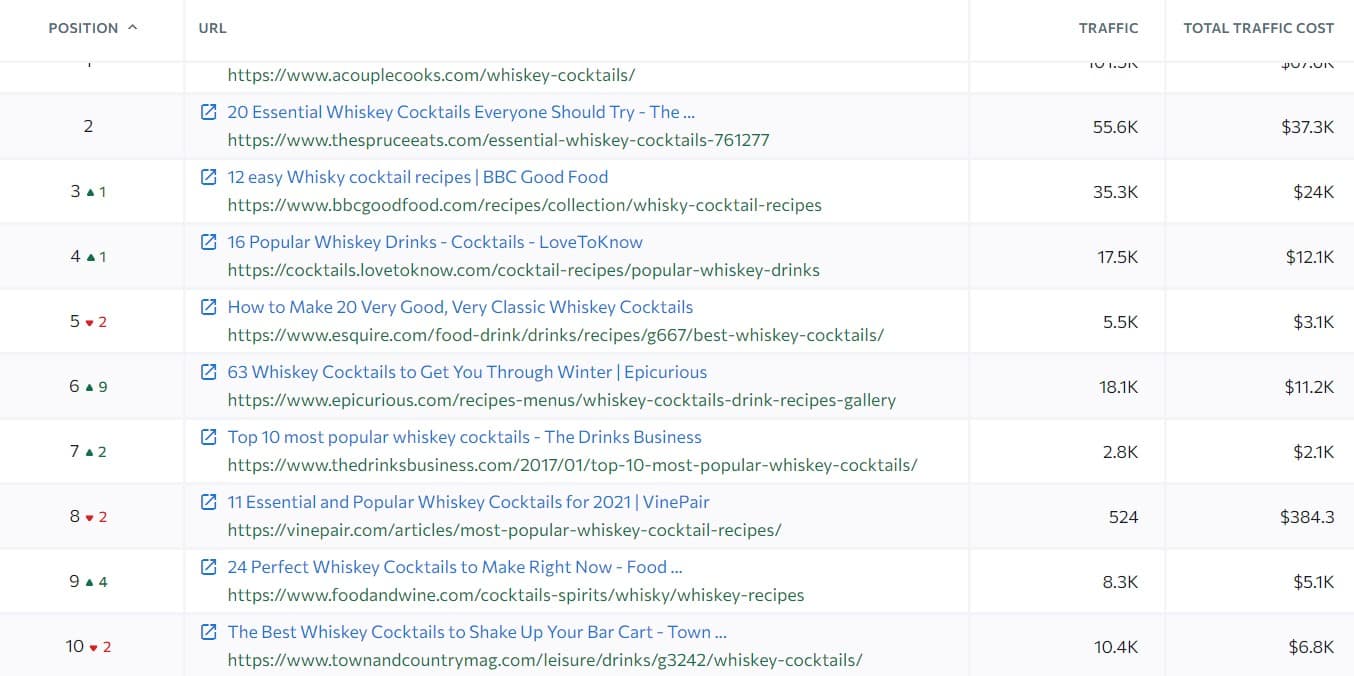
And I would definitely add those cocktails that most of the competitors included as well.
However, if your keyword is more topic-based, then I recommend you go through the ranking competitors, you will see what topics each of them covered in their articles and you will want to address those topics as well in your article and even consider adding one or two extra topics to play it safe.
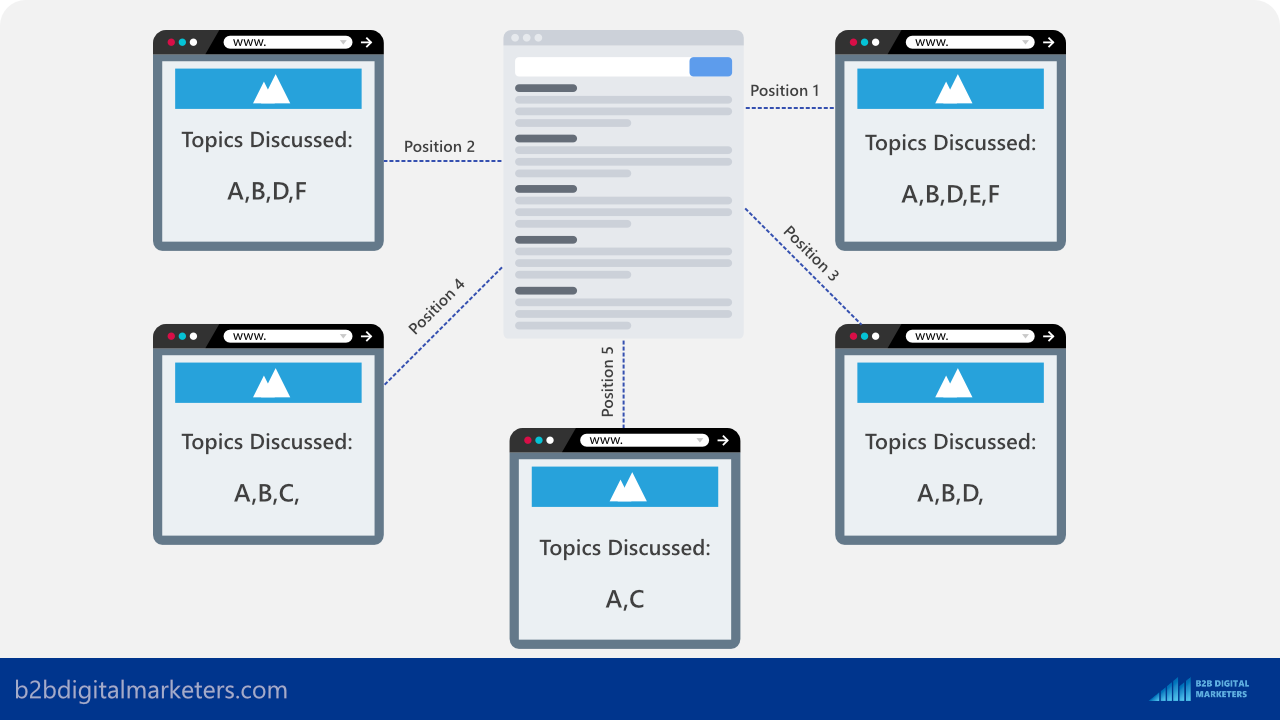
Technique #3: Checkout Keyword Suggestions from Keyword Tools
Another way is to pop your targeted keyword into the keyword research tool and see what other related keywords you can find.
This technique is a great way to find different ways how to say “best whiskey cocktails” so I don’t end up with keyword stuffing and also improve my ranking for related terms.
For example keywords like “drinks made with whiskey”, “cocktail recipes with whiskey”, “best whisky drinks” and “good whiskey drinks” are basically the same thing, thus the same types of pages are ranking for these keywords.
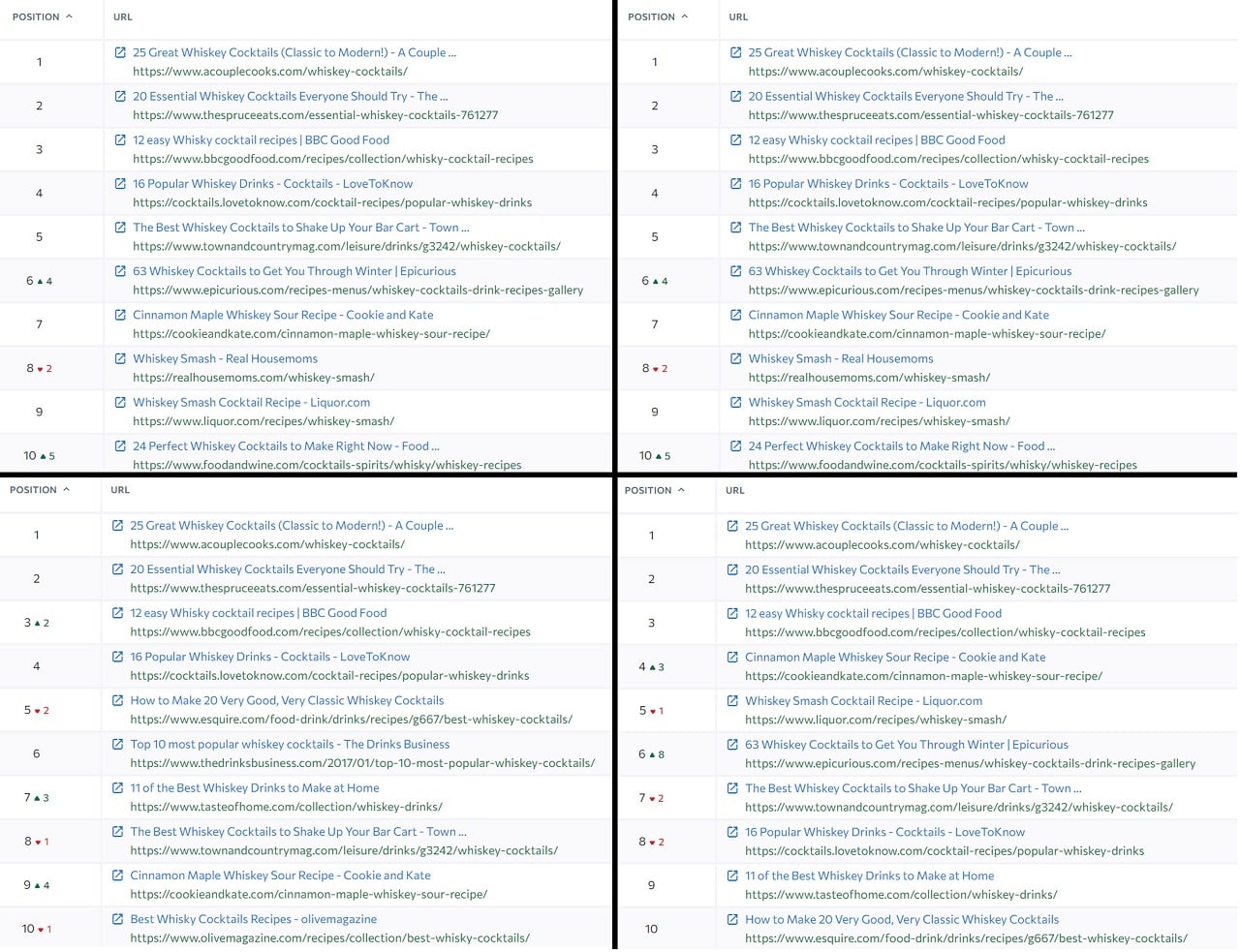
However, this allows me to avoid keyword stuffing and improve my keyword targeting for these related terms and maximize my SEO potential.
Then I can also see, that some of the related keywords are “whiskey mixed drinks”, best whiskey for old fashioned”, and “how to make whisky” that I can mention within my article as a subtopic and link to my full article targeting these specific keywords.
Finding these keywords is a great way to extend your article with more information, improve your ranking for more articles and increase your topical relevancy.
Best Keyword Analysis Tools
1. SE Ranking
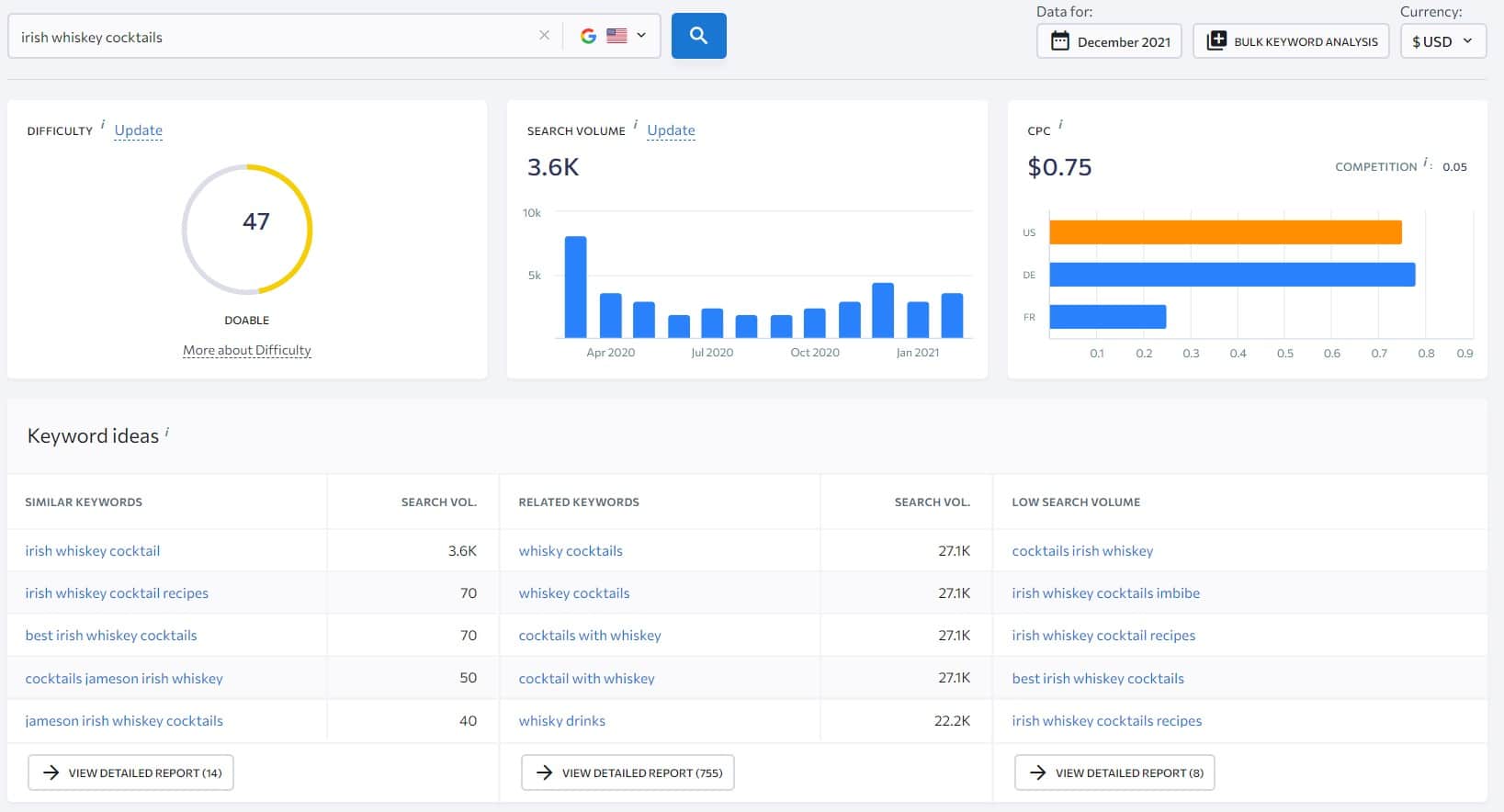
SE Ranking is one of the top SEO tools in the market with over 30 tools for every task in search marketing. They offer one of the largest keyword databases in the world and a super intuitive and user-friendly design that makes SEO super simple.
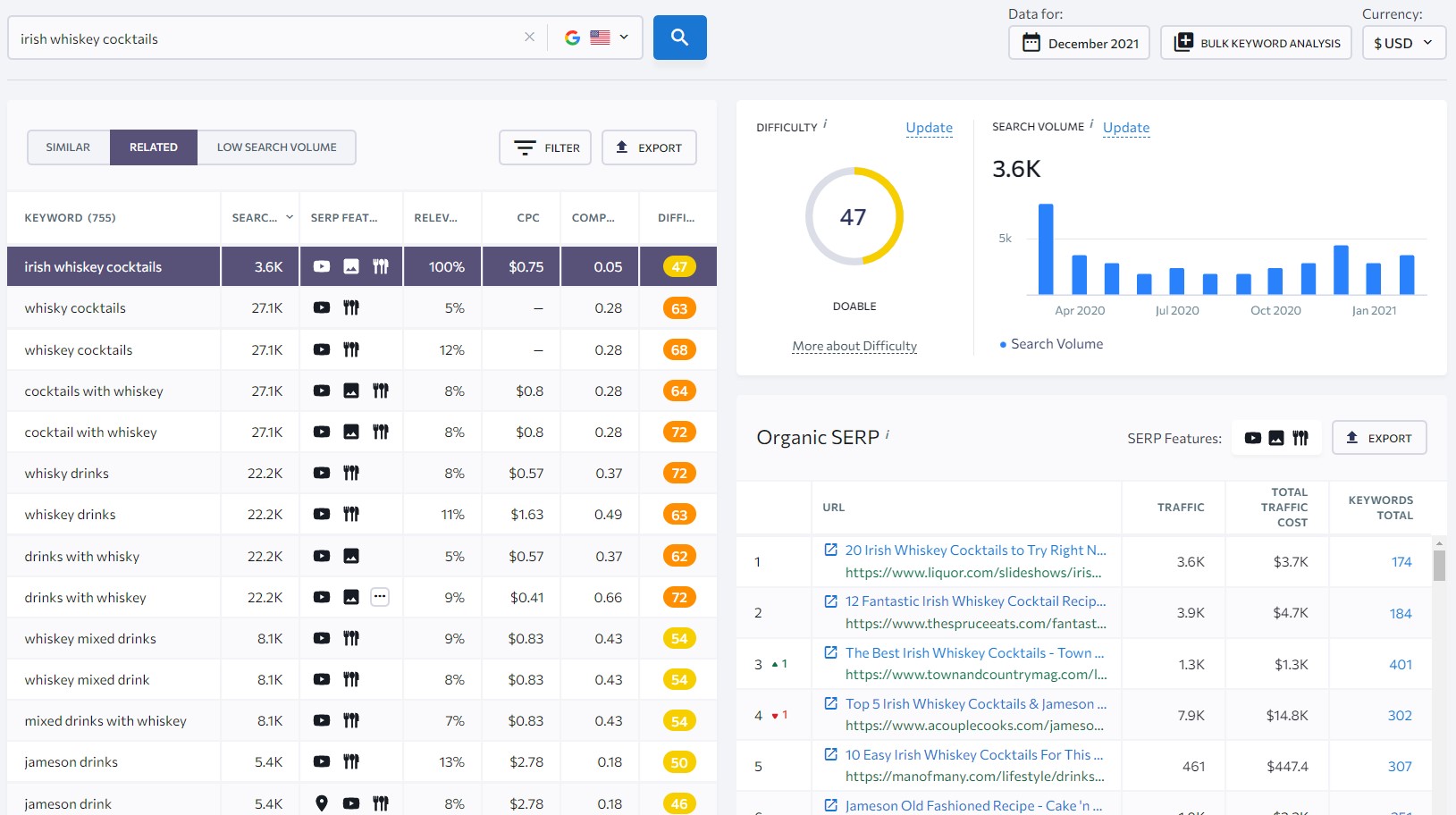
The biggest advantage of using SE Ranking except pricing is that they offer a 100% accurate rank tracker with keyword history and organic SERP history, thus giving you another way to analyze and track your keywords.
SE Ranking offers by far the best value for money which makes it available for specialists and companies with limited marketing budgets. They give you a 14-days free trial and their pricing starts for as little as $18 p/m making SEO far affordable than their competitors.
2. SEMRush

SEMRush is one of the leading SEO tools on the market offering over 50 tools for search marketing practices. The platform gives you in-depth keyword analysis and a large number of keyword ideas with even a larger set of data with endless granular options. It is definitely a great tool for serious marketers and SEOs to step up their game.

The greatest advantage of SEMrush is their robust platform that offers almost everything you can think of and needs for SEO, content marketing, social media marketing, SEM, and more and not just keyword analysis.
Of course, a robust platform like SEMRush also comes with a hefty price. They do offer a Free version with limited access, which is still great for marketers to get a feel of the tool and use it. However, once you decide to use the tool properly, prepare to pay $120 a month for still very limited access and if you want full access, then you will be paying $450 p/m. Definitely not a cheap tool, but worthy.
3. KWFinder

KWFinder is a great and simple tool to analyze your keywords without subscribing to more expensive alternatives. It is one of the easiest tools to use on market recommended for beginners to learn how to do keyword research. It is definitely a keyword analysis tool you will enjoy using on daily basis.
The biggest advantage of KWFinder is its user-friendly design that even rookies can learn how to use with free limited access. This helps those that are just starting with their blog or website as a side business or for fun and wants to learn easily how to perform basic keyword research.
When it comes to pricing, they are starting with 29$ that gives you access to Mangools set of tools which are still very cheap in the industry.
4. Ubersuggest
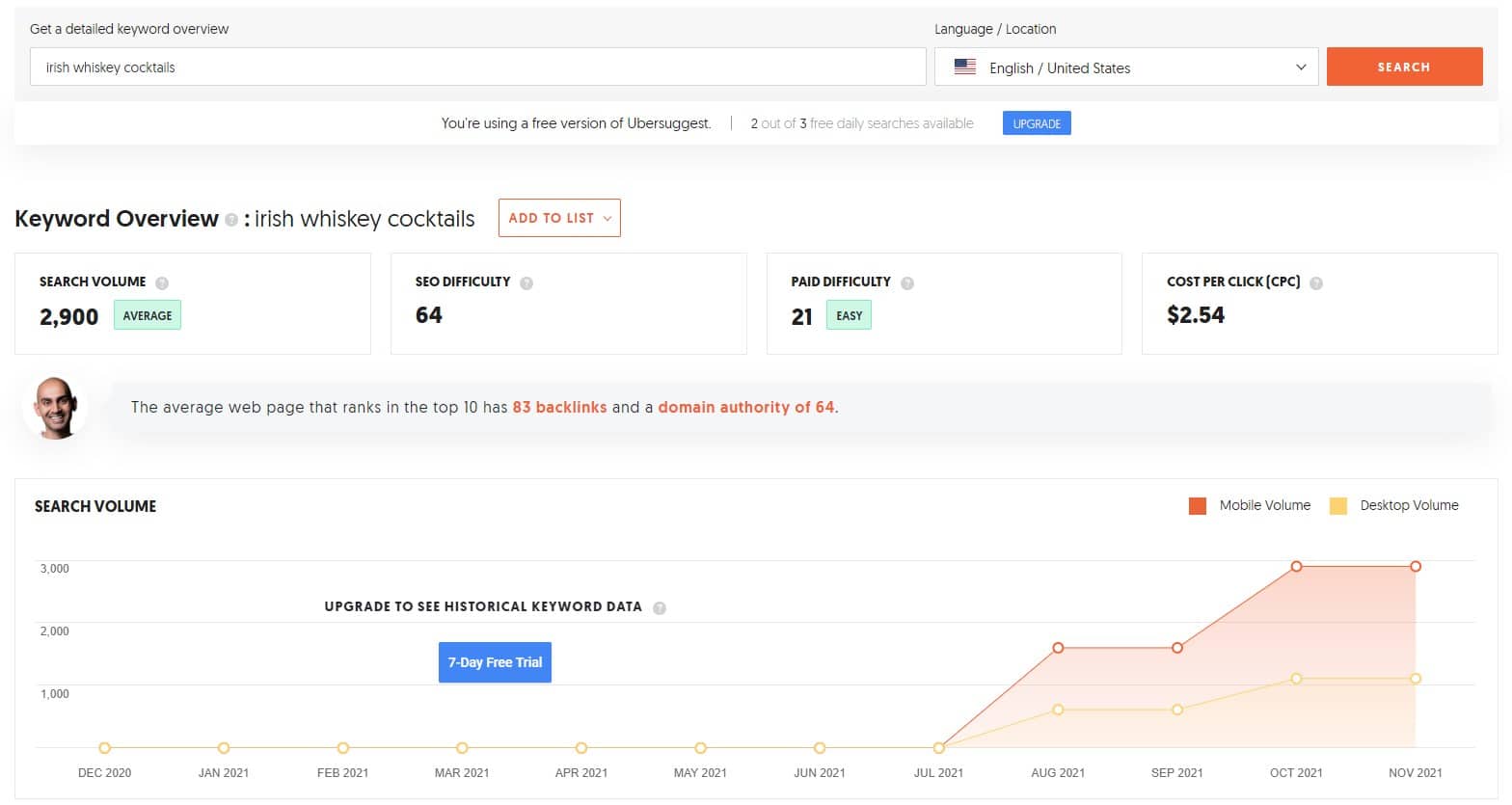
Ubersuggest started as a keyword research tool and even despite Neil Patel has expanded its capabilities beyond keyword research, it is still one of the best keyword research and analysis tools on the market, offering great data for your keywords in a nice looking design. Ubersuggest is a more complex SEO tool, but it is still considered one of the easiest SEO tools for SEO and blogger rookies.
The big advantage of Ubersuggest is that keyword analysis and keyword research was the main focus and still, it is one of the best keyword research tools on the market. The tool offers a lot of keyword ideas, questions keywords, prepositions, and comparisons keywords giving you tons of great and unique keyword ideas.

Ubersuggest is a Freemium tool offering free access to a limited, yet still a very good version of their keyword research tool as well as other tools. But Neil also offers super friendly and affordable pricing starting as little as $12 a month or buying a lifetime subscription for only $120. Also check out Ubersuggest alternatives
5. Keyword Tool
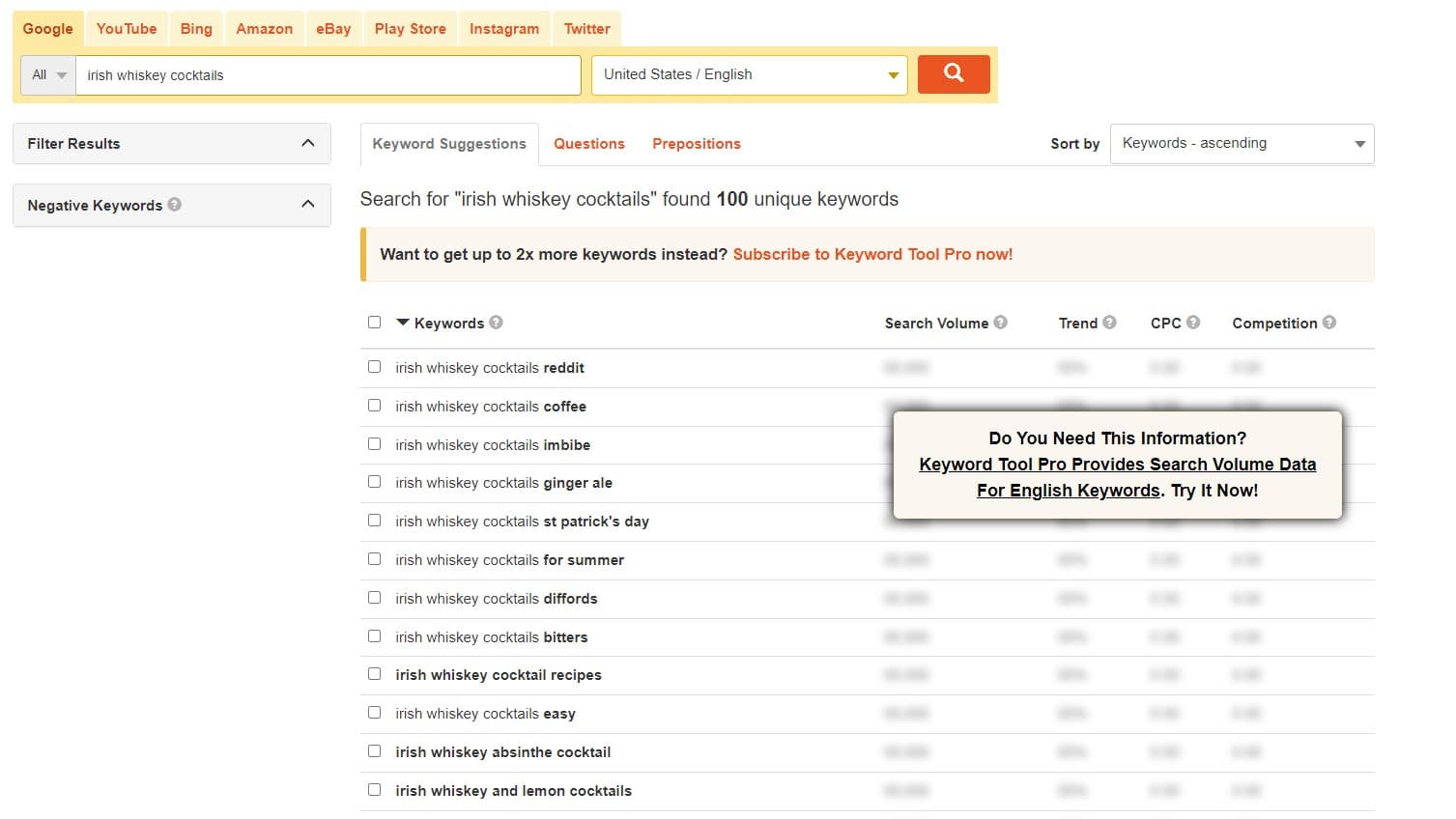
Keyword Tool is free keyword research and keyword analysis tool offering an excellent list of keyword ideas and long-tail keywords suggestions for every search term. It is definitely the best alternatives to paid keyword research tools.
The biggest advantage of Keyword Tool is that they offer a great free version with tons of keyword suggestions allowing anybody to find keyword ideas across different search engines. Also, the tool uses Autocomplete from different search engines to get keywords that are hidden for other SEO tools.
The pricing for Keyword Tool is free, but you don’t get access to any data. However, the pricing starts at $69 per month, which can be billed only annually and they will give you access to all of the keywords in their database as well as to keyword data, but not to all of them.
Final Advice
And that’s all the steps for the keyword analysis process.
Maybe now you seem a bit overwhelmed from all these steps, but with a bit of practice you will find out that you start doing this automatically even during the keyword research process.
In fact, when I do the keyword research, I also do keyword analysis at the same time, to only get high-quality keywords for myself and my clients.
And regarding the tools, there are so many more on the market, these are just some of my favorite that I can recommend to you. But don’t feel afraid to try all of them to see for yourself which one works for you.
Also, let me know on my YouTube channel if I forget something or you found something particularly helpful.
Related Articles:
- Content Gap Analysis: The Ultimate Guide
- How Do I Find SEO Keywords? 11 Best Techniques
- How to Find profitable Keywords for Your Website?
- Semantic SEO: Ultimate Guide
- Blog SEO: Best Tips & Practices to Get You Started
- How to Find Keywords on a Website
- SEO Strategy: How to Start with SEO [2022]
- Competitor Research Tool: 12 Best Ways How to Use It
Also, check out our SEO hub page to find all our SEO resources.
Disclaimer
This article was created by Eduard Dziak and may contain affiliate links. The following were used to optimize the article for the best user and search engine experience include:
- SE Ranking for keyword research and on-page SEO optimization
- Surfer SEO for SEO-friendly content creation for users and search engines.
- Jasper AI for grammar correction and information enhancement.
The article is based on the author’s own experience and knowledge, drawn from both their own work and that of their clients, to provide the latest, proven methods.








